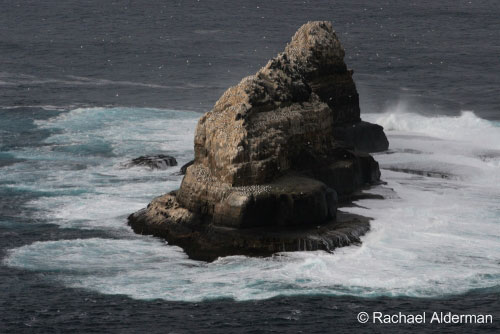Rachael Alderman (Department of Primary Industry, Parks, Water and Environment, Hobart, Australia) and colleagues writing in the journal Wildlife Research late last year have concluded that the global population of Australia's endemic Shy Albatross Thalassarche cauta is "likely to be stable at best and quite possibly decreasing".
The paper's abstract follows:
"Context. Monitoring the status of albatross populations and identifying the factors driving observed trends remain international conservation and management priorities. The shy albatross is endemic to Australia and breeds only on three Tasmanian islands.
Aims. To provide a reliable total population estimate for shy albatross, including an assessment of demographic trends for each of the three populations where possible. We consider also key drivers of population trends for each population, particularly the potential role of fisheries by-catch, with an overall aim of determining the status of the species.
Methods. Aerial photography and ground surveys were used to estimate the number of annual breeding pairs and trends in adult and juvenile survival rates were calculated using mark-recapture methods. At-sea distribution data was used to identify population specific trends in the overlap of shy albatross and fisheries to evaluate the potential influence of fisheries by-catch on the populations.
Key Results. The Albatross Island population increased post-harvesting but has recently stabilised at around 5200 breeding pairs, less than half its estimated historic size. This trajectory change appears driven by a decrease in juvenile survival. The small (170 breeding pairs) Pedra Branca population has recently declined, probably due to reduced breeding success associated with the increasing population of Australasian gannets (Morus serrator) on the island. The largest population (on Mewstone) comprises at least 9500 breeding pairs. Trends for this population are unknown. However, this paper demonstrates that these birds have greater overlap with trawl and longline fishing effort and are consequently at higher risk of fishing-related mortality.
Conclusions. Given the extent of fisheries overlap, survival rates for Mewstone individuals are likely to be lower than the Albatross Island population. Combined with recent trends on Pedra Branca and Albatross Island, we suggest that the current status of the shy albatross is likely to be stable at best and quite possibly decreasing.
Implications. The concerns raised about the conservation status of shy albatross reinforce the importance of continued population monitoring focussed [sic] particularly on establishing the trend of Mewstone. A thorough assessment of interactions with trawl fishing operations also is a management priority for this species."



Albatross Island, Mewstone and Pedra Branca
Photographs by Rachael Alderman
Reference:
Alderman, R., Gales, R., Tuck, G.N. & Lebreton, J.D. 2011. Global population status of shy albatross and an assessment of colony-specific trends and drivers. Wildlife Research 38: 672-686.
With thanks to Barry Baker for information.
John Cooper, ACAP Information Officer, 9 April 2012

 English
English  Français
Français  Español
Español